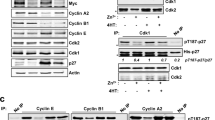Abstract
The c-myc proto-oncogene plays an important role in the regulation of cell proliferation, differentiation and apoptosis. It encodes a transcription factor of the basic region/helix-loop-helix/leucine zipper (bHLHZip) family and binds specifically to certain E-box DNA elements and activates transcription from promoters containing such elements by forming heterodimers with the bHLHZip protein Max (Blackwood et al. 1991, Prendergast et al. 1991, for review see Henriksson and Lüscher 1996). Max on the other hand was recently shown to form heterodimers with a number of other bHLHZip proteins; Mad1, Mxi1, Mad3 and Mad4, referred to as the Mad family (Ayer et al. 1993, Zervos et al. 1993, Hurlin et al. 1995a). These are, like c-Myc, dependent on Max for their activity and bind the same DNA elements as Myc:Max heterodimers. The Mad proteins seem to act as negative regulators of growth and inhibit the transactivating and transforming capacity of Myc (for review see Henriksson & Lüscher 1996). This repressive activity depends on the N-terminus of Mad which is required for interaction with mammalian homologues of the yeast repressor protein Sin3 (Ayer et al. 1995, Schreiber-Agus et al. 1995).
Access this chapter
Tax calculation will be finalised at checkout
Purchases are for personal use only
Preview
Unable to display preview. Download preview PDF.
Similar content being viewed by others
References
Ayer DE, Eisenman RN (1993) A switch from Myc:Max to Mad:Max heterocomplexes accompanies monocyte/macrophage differentiation. Genes Dev 7:2110–2119.
Ayer DE, Kretzner L, Eisenman RN (1993) Mad: a heterodimeric partner for Max that antagonizes Myc transcriptional activity. Cell 72:211–222.
Ayer DE, Lawrence QA, Eisenman RN (1995) Mad-Max transcriptional repression is mediated by ternary complex formation with mammalian homologs of yeast repressor Sin3. Cell 80:767–776.
Blackwood EM, Eisenman RN (1991) Max: a helix-loop-helix zipper protein that forms a sequence-specific DNA-binding complex with Myc. Science 251:1211–1217.
Blackwood E.M, Lüscher B, Eisenman RN (1992) Myc and Max associate in vivo. Genes & Dev. 6:71–80.
Henriksson M, Luscher B (1996) Proteins of the Myc network: essential regulators of cell growth and differentiation. Adv Cancer Res 68:109–182.
Hurlin PJ, Queva C, Koskinen PJ, Steingrimsson E, Ayer DE, Copeland NG, Jenkins NA, Eisenman RN (1995a) Mad3 and Mad4: novel Max-interacting transcriptional repressors that suppress c-myc dependent transformation and are expressed during neural and epidermal differentiation. EMBO J 14:5646–5659.
Hurlin PJ, Foley KP, Ayer DE, Eisenman RN, Hanahan D, Arbeit JM (1995b) Regulation of Myc and Mad during epidermal differentiation and HPV-associated tumorigenesis. Oncogene 11:2487–2501.
Klefstrom J, Vastrik I, Saksela E, Valle J, Eilers M, Alitalo K (1994) c-Myc induces cellular susceptibility to the cytotoxic action of TNF-alpha. EMBO J 13:5442–5450.
Larsson LG, Ivhed I, Gidlund M, Pettersson U, Vennstrom B, Nilsson K (1988) Phorbol ester-induced terminal differentiation is inhibited in human U-937 monoblastic cells expressing a v-myc oncogene. Proc Natl Acad Sci U S A 85:2638–2642.
Larsson LG, Oberg F, Stockbauer P, Masucci MG, Nilsson K (1992) Suppression of basal, PMA- and IFN-alpha-, but not IFN-gamma-induced expression of HLA class I in v-myc- transformed U-937 monoblasts. Int J Cancer 52:759–765.
Larsson LG, Pettersson M, Oberg F, Nilsson K, Luscher B (1994) Expression of mad, mxi1, max and c-myc during induced differentiation of hematopoietic cells: opposite regulation of mad and c-myc. Oncogene 9:1247–1252.
Luscher B, Eisenman RN (1988) c-myc and c-myb protein degradation: effect of metabolic inhibitors and heat shock. Mol Cell Biol 8:2504–2512.
Massague’, J (1996) TGFß signalling: receptors, transducers and Mad proteins. Cell 85:947–950.
Oberg F, Larsson LG, Anton R, Nilsson K (1991) Interferon gamma abrogates the differentiation block in v-myc-expressing U-937 monoblasts. Proc Natl Acad Sci USA 88:5567–5571.
Prendergast GC, Lawe D, Ziff EB (1991) Association of Myn, the murine homolog of max, with c-Myc stimulates methylation-sensitive DNA binding and ras cotransformation. Cell 65:395–407.
Schreiber-Agus N, Chin L, Chen K, Torres R, Rao G, Guida P, Skoultchi AI, DePinho RA (1995) An amino-terminal domain of Mxil mediates anti-Myc oncogenic activity and interacts with a homolog of the yeast transcriptional repressor SIN3. Cell 80:777–786.
Taniguchi T (1995) Cytokine signaling through nonreceptor protein tyrosine kinases. Science 268:251–255.
Vastrik I, Kaipainen A, Penttila TL, Lymboussakis A, Alitalo R, Parvinen M, Alitalo K (1995) Expression of the mad gene during cell differentiation in vivo and its inhibition of cell growth in vitro. J Cell Biol 128:1197–1208.
Zervos AS, Gyuris J, Brent R (1993) Mxil, a protein that specifically interacts with Max to bind Myc-Max recognition sites. Cell 72:223–232.
Author information
Authors and Affiliations
Editor information
Editors and Affiliations
Rights and permissions
Copyright information
© 1997 Springer-Verlag Berlin Heidelberg
About this chapter
Cite this chapter
Larsson, LG., Bahram, F., Wu, S., Öberg, F., Nilsson, K., Lüscher, B. (1997). Cytokine-induced Inhibition of Myc Activity in Monocytic Cells. In: Potter, M., Melchers, F. (eds) C-Myc in B-Cell Neoplasia. Current Topics in Microbiology and Immunology, vol 224. Springer, Berlin, Heidelberg. https://doi.org/10.1007/978-3-642-60801-8_19
Download citation
DOI: https://doi.org/10.1007/978-3-642-60801-8_19
Publisher Name: Springer, Berlin, Heidelberg
Print ISBN: 978-3-642-64560-0
Online ISBN: 978-3-642-60801-8
eBook Packages: Springer Book Archive




